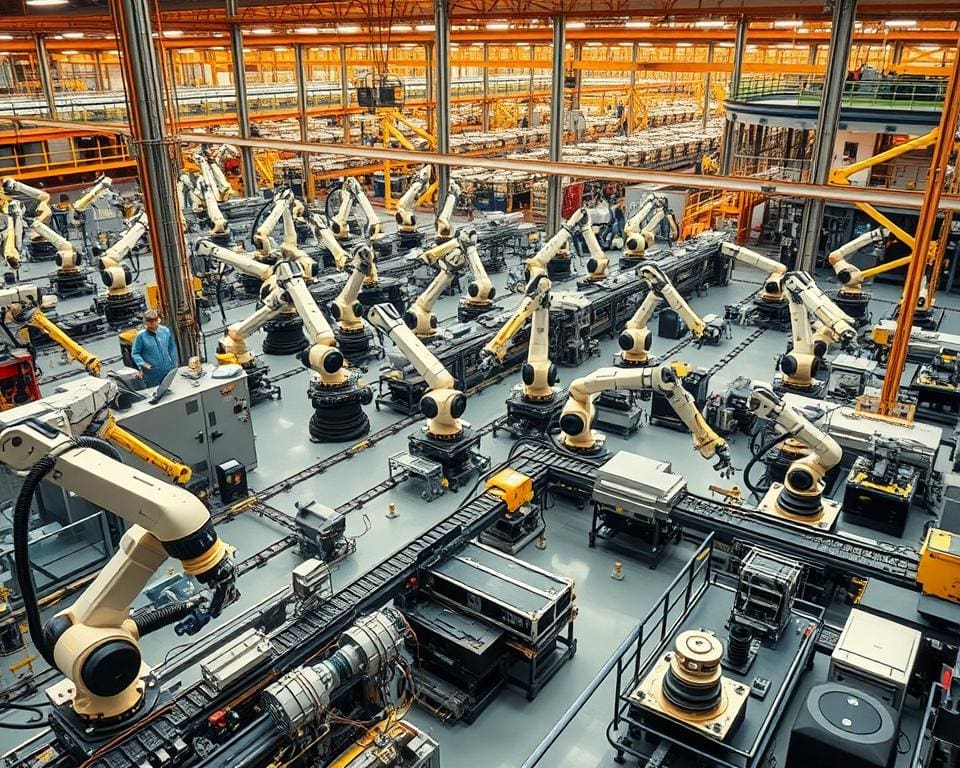In today’s rapidly evolving industrial landscape, robotics in industrial production has emerged as a cornerstone of operations, transforming how businesses operate across various sectors. This revolution in industrial automation is driven by the need for enhanced efficiency, consistency, and productivity in manufacturing. Robots are not only streamlining processes but also adapting to the dynamic demands of the automotive, electronics, and consumer goods industries. As we delve deeper, we will uncover the myriad ways in which robotics support in manufacturing is shaping the future of production, ensuring that industries remain competitive and responsive to the ever-changing market conditions.
The Evolution of Robotics in Industry
The history of robotics traces its roots back to the early 20th century, marking the beginning of a significant transformation in industrial processes. The introduction of early robotics innovations laid a robust foundation for what we see today in robotic technology. One pivotal moment came in 1961 when Unimate, the first industrial robot, was deployed, heralding a new era in manufacturing. Such milestones in robotics set in motion a series of advancements that would reshape production landscapes across various sectors.
Early Developments and Innovations
The drive towards automation saw a remarkable progression through the decades, accompanied by notable inventions and developments. The industrial robotics timeline reveals key achievements, with programmable robots gaining traction in the 1970s and 1980s. These transformative machines brought increased efficiency and precision, significantly enhancing manufacturing capabilities. The subsequent emergence of robotic arms paved the way for multi-functional automation. Techniques such as these played a crucial role in the robotics evolution, allowing industries to optimise operations and reduce reliance on manual labour.
Key Milestones in Robotic Technology
As robotic technology advancements unfolded, several significant milestones stood out. The integration of artificial intelligence into robotic systems marked a turning point, allowing for smarter, adaptive machinery. The introduction of collaborative robots, or cobots, offered the ability to work safely alongside human operators, further amplifying productivity in the workplace. Understanding these milestones in robotics provides insight into how vastly the landscape of production has shifted, paving the way for an ecosystem where humans and robots can coexist and thrive together.
The Role of Robots in Manufacturing Processes
As industries evolve, the integration of robotics in manufacturing plays a crucial role in enhancing operational efficiencies. Automation benefits manifest significantly in various manufacturing processes, particularly through repetitive task automation. This transition helps organisations streamline workflows and maximise productivity.
Automation of Repetitive Tasks
Repetitive task automation reshapes how production lines operate by taking on mundane, labour-intensive duties. By employing robots for these tasks, companies can reduce human error, leading to more consistent output. For instance, assembly line work, packaging, and quality inspection are processes increasingly handled by robotic systems, allowing human workers to focus on more complex, value-added activities. This shift not only optimises time but also enhances throughput, demonstrating a poignant example of how robotics in manufacturing can elevate overall performance.
Enhancing Precision and Quality Control
The contributions of robotics in manufacturing extend beyond simple automation. Robotic precision is vital for maintaining high standards of quality control in manufacturing. Robots are engineered to perform actions with exceptional accuracy, which significantly diminishes flaws in products. Noteworthy implementations include robots equipped with vision systems that facilitate meticulous quality checks, ensuring that items meet stringent industry standards. This integration of robotics in quality assurance not only boosts confidence in product integrity but also reinforces the brand’s reputation in an increasingly competitive market.
How do robots support industrial production today?
Robots have become indispensable in contemporary industrial production, achieving remarkable enhancements in efficiency and precision. By adopting advanced robotics applications, various sectors harness their capabilities to meet unique production challenges. These robotics applications span a multitude of areas, from automotive manufacturing to food and beverage processing, showcasing the versatility of robotic solutions capable of adapting to diverse needs.
Applications Across Various Sectors
Different sectors using robotics have experienced transformative benefits through the deployment of robotic systems. In the automotive industry, robots excel at welding and assembly tasks, ensuring consistent quality and fast production rates. The electronics sector employs robots for intricate assembly processes, contributing to precision in manufacturing. In food and beverage, robots enable rapid packaging and handling, which is crucial for meeting consumer demand. Pharmaceuticals rely on robotics to automate sensitive tasks, ensuring compliance with stringent regulations while maintaining the highest standards of safety.
Integration with Existing Systems
The integration of robotics and existing technology plays a pivotal role in enhancing productivity. Through effective robotic system integration, modern robots can communicate seamlessly with other machinery, fostering a collaborative environment that eliminates bottlenecks. Innovations such as IoT (Internet of Things) enable robots to share data with other systems, optimising workflow and minimising downtime during production processes. This approach to seamless automation not only boosts operational efficiency but also allows businesses to adapt to ever-changing market dynamics.
Impact on Workforce Dynamics
The integration of robotics into various industries presents a complex landscape for the workforce. While concerns regarding job displacement by automation persist, this evolution also stimulates job creation in robotics, opening up avenues for growth that may have remained untapped. Realising the potential of robotics requires a comprehensive understanding of how to balance these dynamics effectively.
Job Creation versus Job Displacement
Statistics indicate that as robots take on tasks previously handled by humans, new roles emerge within the industry. Unlike traditional fears of widespread job loss, many companies report a net increase in employment opportunities, particularly in technical and supervisory positions. The transition from manual labour to robotics-driven production provides pathways for individuals to explore careers that focus on innovation, maintenance, and oversight.
Reskilling and Upskilling Opportunities
To adapt to the shifting paradigms within the workplace, organisations must prioritise the reskilling workforce. Companies are increasingly investing in training in robotics, aiming to prepare existing employees for collaborations with automated systems. Upskilling for automation not only enhances productivity but also fosters a culture of continuous learning. Effective training programmes empower workers to manage and collaborate with robotic technology, ensuring profitable integration and supporting the overall workforce impact.
Benefits of Implementing Robotics in Production
The integration of robotics into production environments offers transformative benefits that extend across various dimensions of a business operation. Achieving efficiency in production stands at the forefront, alongside substantial financial advantages that can reshape the landscape of traditional manufacturing practices.
Increased Efficiency and Productivity
The deployment of robots leads to remarkable productivity gains from robotics. Their capability to operate continuously without fatigue significantly enhances output rates while reducing production time. This continuous operation allows companies to maximise their resources and improve overall operational workflows. Some key ways in which robotics contribute to increased efficiency include:
- Minimised downtime due to swift task execution.
- Improved consistency and quality in product creation.
- Streamlined workflows through precise automation of repetitive tasks.
Cost Savings and ROI
Cost savings with robots are evident in various forms, such as reduced labour expenses, diminished error rates, and less waste during production. These reductions lead to a direct impact on a company’s bottom line. Firms that have embraced robotic systems experience notable return on investment in robotics, justified by the compelling financial benefits of automation. Factors contributing to these savings include:
- Lower long-term operational costs due to fewer resources required.
- Increased accuracy leading to less rework and material waste.
- Enhanced ability to meet consumer demands swiftly and efficiently.
Challenges and Limitations of Robotic Systems
The integration of robots into industrial environments offers numerous advantages, yet it also presents significant challenges and limitations that businesses must navigate. Understanding these hurdles is crucial for companies contemplating investment in robotics. Two major areas of concern include the initial investment and maintenance costs associated with implementing robotic systems, alongside the inherent technical limitations and safety concerns that arise with this advanced technology.
Initial Investment and Maintenance Costs
Investment in robotics often requires a substantial initial outlay that can create financial challenges in automation for many organisations. Expenses can include purchasing the robotic equipment, installation, and integration with existing systems. Beyond the initial costs, there are ongoing robotic system maintenance costs that organisations must consider. Regular maintenance ensures optimal performance and longevity of robotics. Companies may find it beneficial to explore financial support options, such as grants or subsidies, which can alleviate some of the burden associated with these expenses.
Technical Limitations and Safety Concerns
Robotic systems, while highly effective, face various technical challenges in automation that may restrict their capabilities. These limitations can arise from operational boundaries, programming complexities, or adaptability to unforeseen circumstances. The potential for technical failures could impact productivity and operational efficiency. Additionally, safety in robotics remains a top priority as human-robot interactions become increasingly prevalent. Implementing robust safety protocols and comprehensive training ensures a secure working environment, reducing the risks associated with robotic systems. The importance of these measures cannot be understated, as they safeguard both the workforce and the technology itself.
The Future of Robotics in Industrial Production
The future of robotics promises exciting advancements that will reshape the landscape of industrial production in unprecedented ways. As we look ahead, the emergence of AI-driven robots stands out as a pivotal development, enabling machines to learn from their environments and adapt in real-time. This shift not only enhances operational efficiency but also allows for greater customisation, addressing specific needs within various sectors.
Moreover, trends in automation technology are paving the way for a collaborative workspace where robots and humans coexist harmoniously. Industries are increasingly recognising the potential of cobots, or collaborative robots, which are designed to assist workers rather than replace them. This fusion of human intelligence and robotic precision will redefine roles in manufacturing and lead to increased innovation and productivity.
As these advancements in industrial robots continue to evolve, the potential for improved safety, quality control, and cost-effectiveness becomes apparent. Keeping abreast of these developments is crucial for businesses aiming to thrive in a competitive landscape. Embracing this future of robotics signifies not just a commitment to evolving technologies, but also a vision for a more efficient and dynamic industrial sector.









